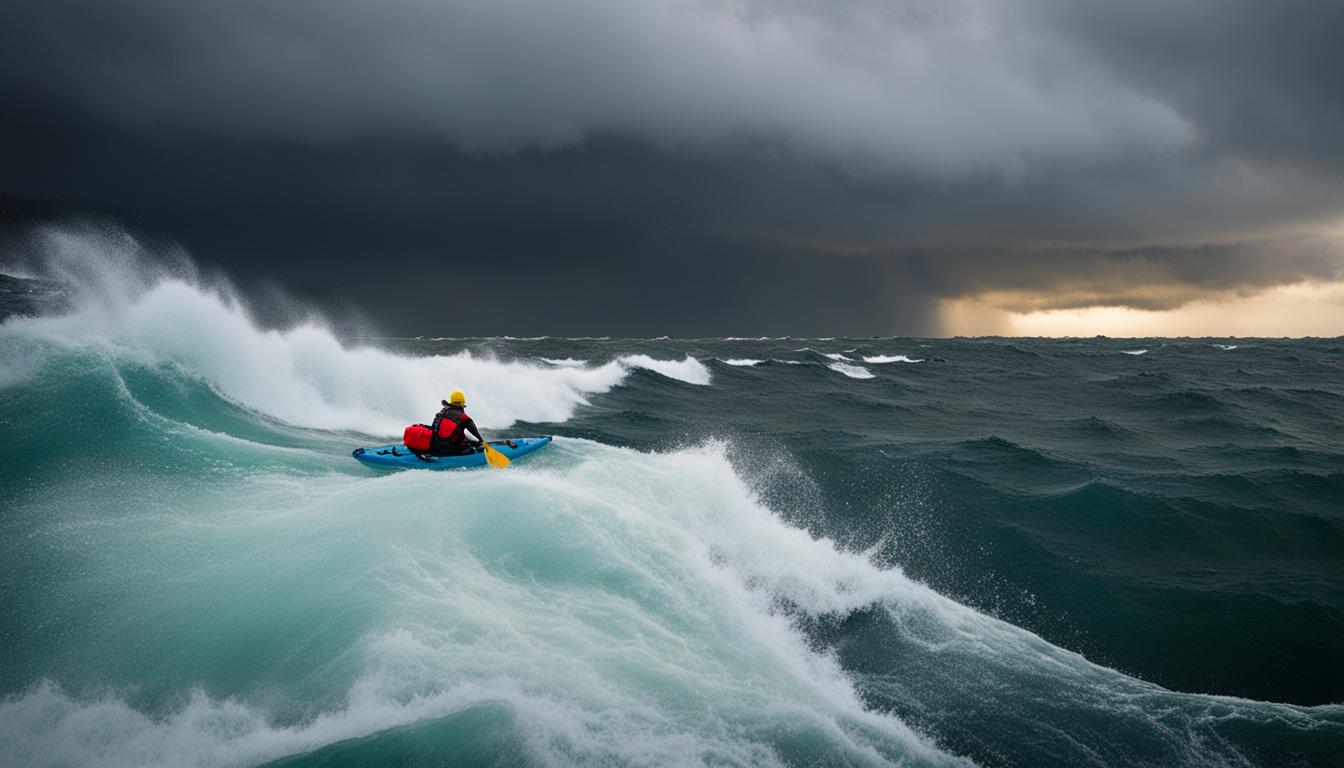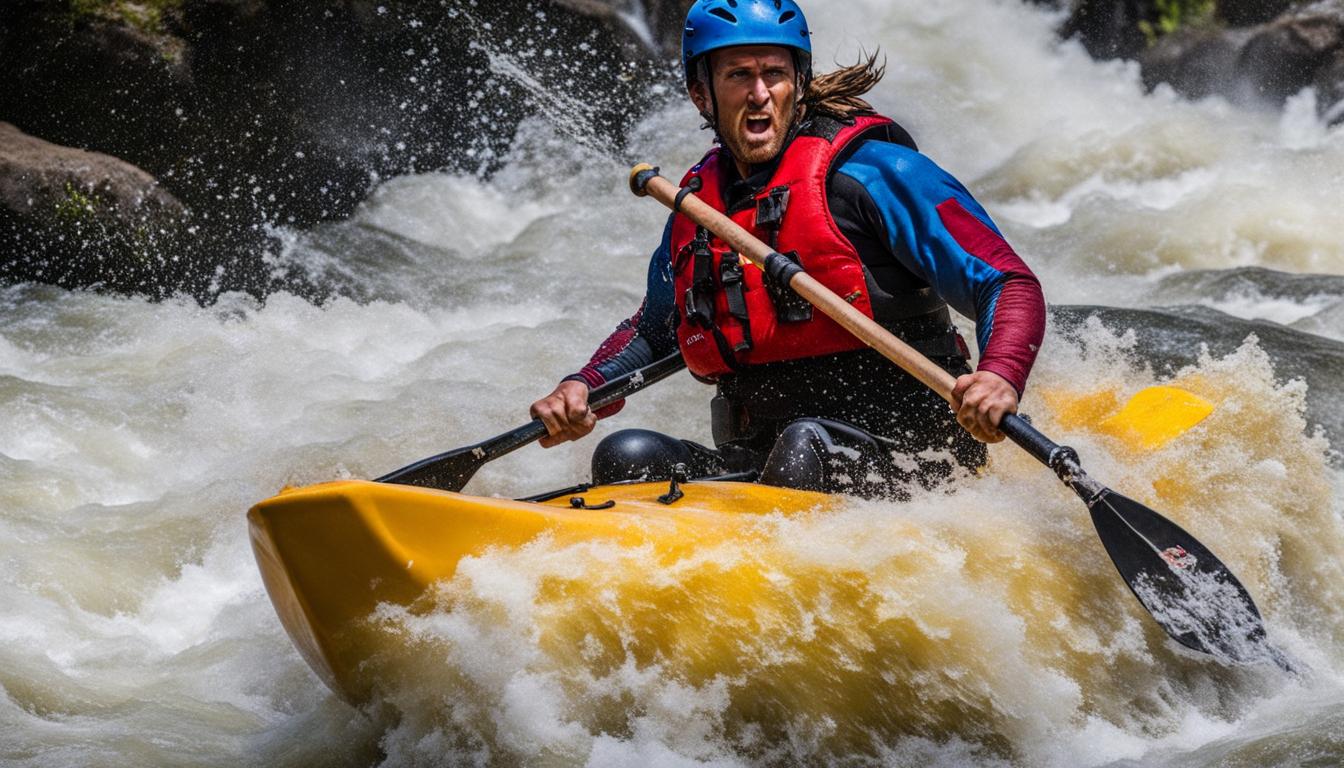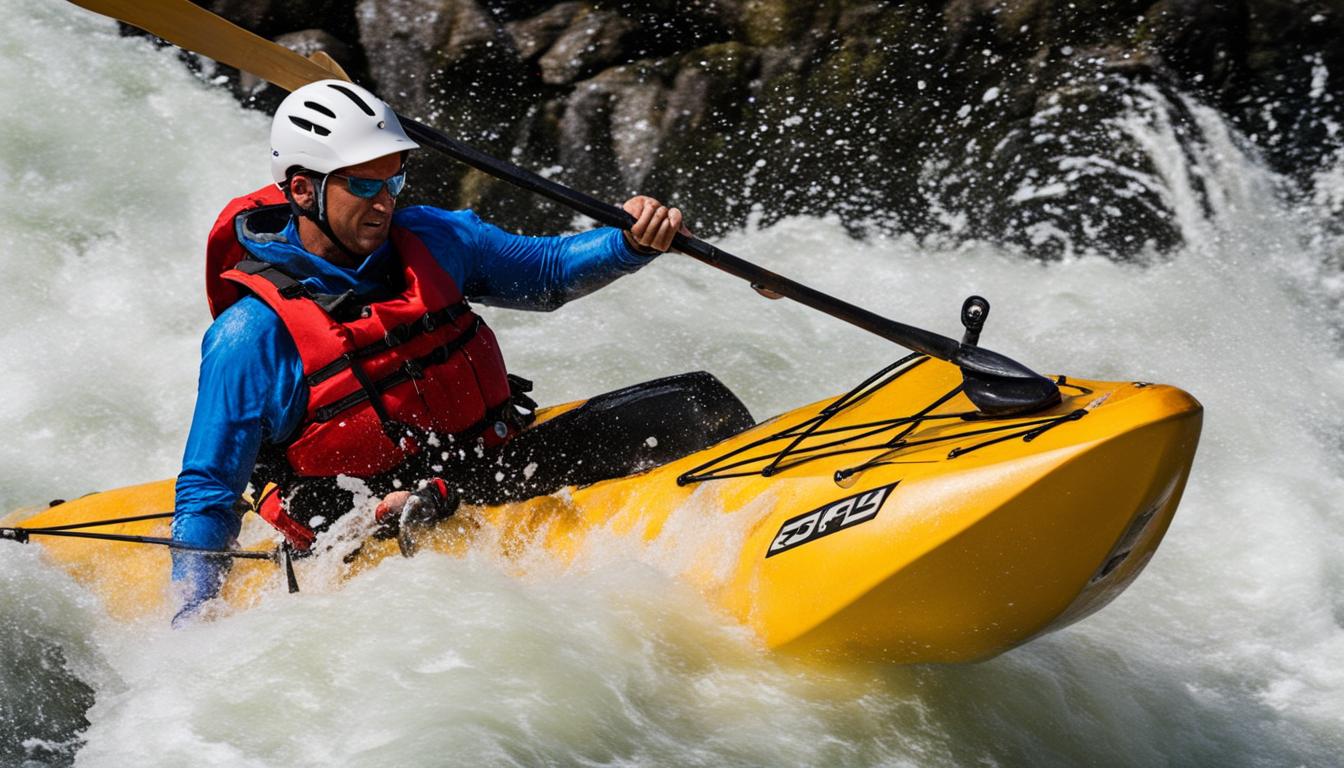Sea kayaking can be a fun and relaxing experience, but it’s important to prioritize safety on the water. Neglecting safety precautions can lead to accidents and injuries. According to a Washington State Park report, 84% of boating accident victims who drowned were not wearing a life jacket. This highlights the importance of following safety guidelines while kayaking. In this article, we will discuss essential safety precautions that all sea kayaking enthusiasts should be aware of in order to have a safe and enjoyable experience on the water.
Key Takeaways:
- Always wear a life jacket while sea kayaking.
- Be aware of weather conditions and plan your kayaking trip accordingly.
- Carry essential safety equipment, such as a bilge pump and first aid kit.
- Inform someone about your paddle plan, including your launch point and expected time of return.
- Practice safe kayaking techniques and stay together when kayaking in a group.
Why Is Kayak Safety Important?
Kayak safety is crucial for several reasons. Firstly, kayaking often takes place in open water, which can be unpredictable and potentially dangerous. Factors like wind and weather conditions can make the water hazardous. Following safety tips for kayaking can help you stay safe on the open water.
“Wearing a life jacket can substantially reduce the risk of drowning in case of an accident.”
Additionally, wearing a life jacket can substantially reduce the risk of drowning in case of an accident. It’s also important to protect against injuries by using proper safety equipment and practicing safe kayaking techniques. Navigating wildlife and knowing how to handle encounters with animals is another aspect of kayak safety. By prioritizing safety, you can continue to enjoy kayaking and have a positive experience on the water.

Taking Steps for Your Safety
When it comes to kayak safety, there are several steps you can take to ensure your well-being on the water:
- Always wear a properly fitted and Coast Guard-approved life jacket.
- Equip yourself with essential safety equipment, such as a whistle, flashlight, and signaling devices.
- Check the weather conditions and water conditions before heading out, and avoid kayaking in extreme weather or rough waters.
- Learn proper kayaking techniques, including how to enter and exit the kayak safely, how to paddle correctly, and how to perform self-rescue techniques.
- Be aware of your surroundings and keep an eye out for other vessels, wildlife, and potential hazards.
By following these safety precautions and being prepared, you can enjoy a safer and more enjoyable kayaking experience.
Tips for Kayaking Safety
When it comes to kayaking safety, there are several important tips to keep in mind to ensure a safe and enjoyable experience on the water. By following these guidelines, you can minimize risks and navigate potential hazards with confidence.
1. Wear a Properly Fitted Life Jacket
A life jacket is a crucial piece of safety equipment that should always be worn while kayaking. Make sure you choose a life jacket that fits properly and is approved by the U.S. Coast Guard. The jacket should be snug but comfortable, allowing you to move freely while ensuring your safety in case of an accident.
2. Be Aware of Hazards
Before you embark on your kayaking adventure, take the time to familiarize yourself with the potential hazards in the area. This includes understanding the local water conditions, such as currents, tides, and wave patterns. Be aware of any potential obstructions, such as rocks or fallen trees, and plan your route accordingly. By being aware of these hazards, you can navigate the water safely and avoid unnecessary risks.
3. Practice Proper Paddling Techniques
Using proper paddling techniques is not only essential for efficient kayaking but also for safety. Make sure you hold your paddle correctly, with your hands shoulder-width apart and your elbows slightly bent. Use your torso to generate power and avoid strain on your arms and shoulders. It’s also important to learn how to perform self-rescues and assisted rescues in case of capsizing or other emergencies.
4. Stay Hydrated and Protect Yourself from the Sun
While out on the water, it’s crucial to stay hydrated and protect yourself from the sun. Bring plenty of water and drink regularly to prevent dehydration. Apply sunscreen with a high SPF to protect your skin from the sun’s harmful rays, and consider wearing a hat and sunglasses for additional protection. Staying hydrated and protecting yourself from the sun will help ensure your comfort and well-being during your kayaking trip.
| Kayaking Safety Tips | Sea Kayaking Hazard Awareness |
|---|---|
| Wear a properly fitted life jacket | Be aware of local water conditions |
| Know and practice proper paddling techniques | Identify potential hazards in the area |
| Stay hydrated and protect yourself from the sun |
Table: Essential Kayaking Safety Tips and Sea Kayaking Hazard Awareness.
By following these tips for kayaking safety, you can have a memorable and safe experience on the water. Remember to always prioritize your safety and take the necessary precautions before venturing out on your kayaking adventure.
Safe Travel and Group Dynamics
When kayaking in a group, safety should be a top priority. By implementing safe travel practices and maintaining group dynamics, you can enhance the overall safety of your kayaking adventure.
Staying together as a group is essential for safety reasons. It provides strength in numbers and ensures that everyone has the necessary resources in case of an emergency. When kayaking in a group, designate a head kayak to lead the way and a last kayak to act as the safety point. It’s important to stay between these two kayaks and not venture off without informing someone. This helps prevent anyone from getting strung out beyond yelling distance.
When crossing busy channels, forming a line perpendicular to the direction of travel can make the group more visible to larger boats and allow them to maneuver around. Effective communication within the group is crucial for maintaining safety. Establish signals or hand gestures that can be used to communicate important information or warnings during the kayaking trip. By staying together and practicing safe travel, you can reduce the risk of accidents and ensure a safer kayaking experience for everyone involved.
Group Kayaking Safety Tips:
- Designate a head kayak and a last kayak for group travel
- Stay between the head kayak and last kayak to prevent straying
- Use hand signals or gestures for effective communication
- Form a line perpendicular to the direction of travel when crossing busy channels
- Follow the lead of the head kayak and maintain group dynamics
By following these group kayaking safety tips and prioritizing safe travel, you can enjoy a more secure and enjoyable kayaking experience with your fellow paddlers.
| Safe Travel and Group Dynamics Tips | Benefits |
|---|---|
| Stay together as a group | Strength in numbers, necessary resources |
| Designate a head kayak and a last kayak | Leadership, safety point |
| Communicate with hand signals or gestures | Effective communication, important information sharing |
| Form a line perpendicular to busy channels | Increased visibility to larger boats, maneuverability |
| Maintain group dynamics | Coordinated and organized travel |
Image related to Safe Travel and Group Dynamics:

Picture reference: Group Kayaking Safety
Emergencies and Individual Responsibility
When it comes to sea kayaking, it’s important to be prepared for emergencies and take individual responsibility for your safety. By understanding and following the proper sea kayaking emergency procedures, you can effectively handle unexpected situations that may arise on the water.
One of the key aspects of sea kayak safety is knowing how to perform rescue techniques. These techniques can help you assist others in need and ensure everyone’s safety. It’s important to learn and practice skills such as self-rescue, towing techniques, and assistance in capsize situations. By being well-prepared and knowledgeable in these techniques, you can be proactive in emergencies and potentially prevent further harm.
In addition to knowing the necessary rescue techniques, having the right sea kayak safety equipment is essential. This includes items such as a life jacket or personal flotation device (PFD), a whistle or signaling device, a bilge pump, and a first aid kit. These items can help you stay afloat, attract attention, remove water from the kayak, and provide basic medical assistance if needed.
Remember that being prepared for emergencies is just as important as taking individual responsibility. It’s crucial to be aware of your own skill level and not venture beyond it, avoiding unnecessary risks. Before heading out on the water, always check the weather conditions and be prepared to adjust your plans accordingly. By taking these precautions and staying vigilant, you can ensure a safe and enjoyable sea kayaking experience.
Sea Kayaking Emergency Procedures:
- Stay calm and assess the situation.
- If someone is in distress, offer assistance if you are trained to do so.
- Call for help using a signaling device or by shouting for assistance.
- If a capsize occurs, perform a self-rescue or assist others in need.
- If necessary, use a towline to help bring someone back to safety.
- Communicate with your group and ensure everyone is accounted for.
- If needed, administer basic first aid to yourself or others.
- Contact emergency services and provide them with your location and any relevant information.
By following these emergency procedures and taking individual responsibility for your safety, you can enjoy a worry-free sea kayaking adventure.
Dressing and Paddle Planning
When it comes to sea kayaking, dressing appropriately and planning your paddle are essential for your safety. The right clothing and gear can protect you from the elements and ensure that you’re prepared for any situation that may arise on the water.
Choosing the right life jacket is crucial for kayaking safety. It is essential to wear a properly fitted personal floatation device (PFD) at all times while kayaking. In warm weather, inflatable PFDs are preferred as they provide comfort and freedom of movement. On the other hand, foam vest PFDs are more suitable for cool or cold weather conditions as they offer insulation against the cold water.
Prior to heading out on the water, it is important to have a paddle plan in place. A paddle plan involves informing someone about your kayaking trip, including the launch point, direction of travel, and expected time of return. This way, if you encounter any unexpected delays or emergencies, someone will be aware of your whereabouts and can assist if needed.
By dressing appropriately for the weather conditions and having a paddle plan, you can enhance your safety while kayaking and ensure a more enjoyable experience on the water.
Table: Recommended Paddle Planning Checklist
| Item | Description |
|---|---|
| Launch Point | The location where you will start your kayaking journey. |
| Direction of Travel | The route you plan to take while kayaking. |
| Expected Time of Return | The estimated time you will be back from your kayaking trip. |
| Emergency Contact | The person you have informed about your plans and whom to contact in case of an emergency. |
| Emergency Equipment | The safety equipment you have packed, such as a whistle, flashlight, and first aid kit. |
Having a paddle plan checklist can help ensure that you have all the necessary information and resources for a safe kayaking trip.
Conclusion
Staying safe while sea kayaking is of utmost importance. By following essential safety precautions, using the right kayaking gear, and implementing sea kayaking safety tips, you can ensure a secure and enjoyable experience on the water.
Always remember to wear a proper life jacket, practicing correct paddling techniques, and being equipped with essential safety gear. These measures will help minimize any potential risks and keep you safe during your kayaking adventure.
Additionally, staying informed about weather conditions, dressing appropriately for the elements, and creating a paddle plan are crucial steps in maintaining your safety. By taking personal responsibility and prioritizing safety, you can have a rewarding and memorable sea kayaking journey.
Stay Safe, Enjoy the Adventure
By adhering to the recommended safety guidelines and staying up to date with the latest sea kayaking safety practices, you can fully embrace the thrill of sea kayaking while ensuring your own well-being. So, get out there, paddle with confidence, and have an amazing time exploring the wonders of the open water!
FAQ
Why is sea kayaking safety important?
Sea kayaking safety is important because it helps prevent accidents and injuries. Open water can be unpredictable and hazardous, and neglecting safety precautions can lead to dangerous situations. Prioritizing kayak safety, such as wearing a life jacket and using proper safety equipment, reduces the risk of drowning and protects against injuries.
What are some essential safety tips for sea kayaking?
Some essential safety tips for sea kayaking include staying together as a group, following safety signals, and practicing safe travel techniques. It’s important to communicate effectively within the group and maintain group dynamics. Additionally, being prepared for emergencies, taking individual responsibility for safety, and dressing appropriately for weather conditions are crucial aspects of safe sea kayaking.
How can I ensure safe travel and group dynamics while kayaking?
To ensure safe travel and group dynamics while kayaking, it’s important to stay together as a group and follow the lead of the head kayak. The last kayak should act as the safety point, and it’s crucial to stay between these two kayaks. When crossing busy channels, forming a line perpendicular to the direction of travel can make the group more visible to larger boats. Effective communication and following safety signals are also important for maintaining safe travel and group dynamics.
What should I do in case of an emergency while sea kayaking?
In case of an emergency while sea kayaking, it’s important to group up and make decisions in a safe and coordinated manner. Learning and using proper signals can aid in communication during emergencies. Individual responsibility involves knowing your skill level and not venturing beyond it to avoid unnecessary risks. Carrying essential safety equipment like a life jacket, bilge pump, and first aid kit is also important. Creating a paddle plan and informing someone about your trip itinerary can help in case of an unexpected delay or emergency.
How should I dress and plan my paddle for safe kayaking?
Dressing appropriately for the weather conditions is crucial for safe kayaking. Wearing the right clothing and using the appropriate personal flotation device (PFD) for the weather conditions is important. In warm weather, inflatable PFDs are preferred, while foam vest PFDs are suitable for cool or cold weather. Additionally, having a paddle plan is necessary, especially when kayaking out of sight of others. A paddle plan involves informing someone about your kayaking trip, including the launch point, direction of travel, and expected time of return.





